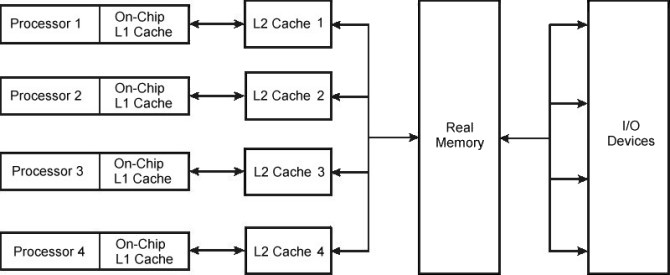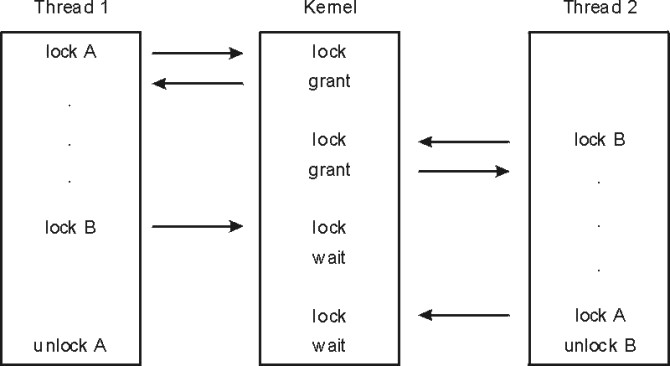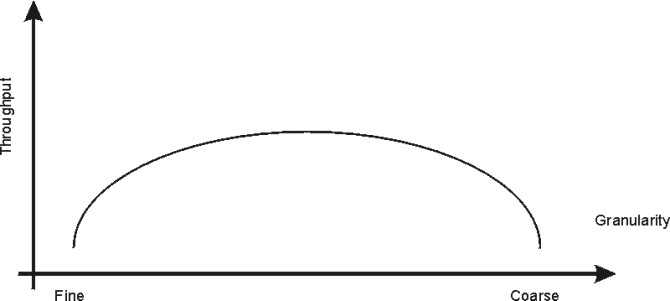
As with any change that increases the complexity of the system, the use of multiple processors generates design considerations that must be addressed for satisfactory operation and performance. The additional complexity gives more scope for hardware/software tradeoffs and requires closer hardware/software design coordination than in uniprocessor systems. The different combinations of design responses and tradeoffs give rise to a wide variety of multiprocessor system architectures.
This section describes the main design considerations of multiprocessor systems and the hardware responses to those considerations.
Several categories of multiprocessing (MP) systems exist, as described below:
Each processor is a complete stand-alone machine and runs a copy of the operating system. The processors share nothing (each has its own memory, caches, and disks), but they are interconnected. When LAN-connected, processors are loosely coupled. When connected by a switch, the processors are tightly coupled. Communication between processors is done through message-passing.
The advantages of such a system are very good scalability and high availability. The disadvantages of such a system are an unfamiliar programming model (message passing).
Processors have their own memory and cache. The processors run in parallel and share disks. Each processor runs a copy of the operating system and the processors are loosely coupled (connected through LAN). Communication between processors is done through message-passing.
The advantages of shared disks are that part of a familiar programming model is retained (disk data is addressable and coherent, memory is not), and high availability is much easier than with shared-memory systems. The disadvantages are limited scalability due to bottlenecks in physical and logical access to shared data.
All of the processors in a shared memory cluster have their own resources (main memory, disks, I/O) and each processor runs a copy of the operating system. Processors are tightly coupled (connected through a switch). Communication between the processors is done through shared memory.
All of the processors are tightly coupled inside the same box with a high-speed bus or a switch. The processors share the same global memory, disks, and I/O devices. Only one copy of the operating system runs across all of the processors, and the operating system must be designed to exploit this architecture (multithreaded operating system).
SMPs have several advantages:
There are some limitations of SMP systems, as follows:
Perhaps the most fundamental decision in designing a multiprocessor system is whether the system will be symmetrical or asymmetrical.
In an asymmetrical multiprocessor system, the processors are assigned different roles. One processor may handle I/O, while others execute user programs, and so forth. Typically one processor is designed as the master and the others are the slaves. The master is a general purpose processor and performs input and output operations as well as computation. The slave processors perform only computation. Use of a slave may be poor if the master does not service slave requests efficiently. I/O-bound jobs may not run efficiently, because only the master executes the I/O operations. Failure of the master is catastrophic. Additional advantages and disadvantages of this approach are as follows:
In a symmetrical multiprocessor system, all of the processors are essentially identical and perform identical functions as follows:
With this interchangeability, all of the processors are potentially available to handle whatever needs to be done next. The cost of this flexibility is primarily borne by the hardware and software designers, although symmetry also makes the limits on the multiprocessability of the workload more noticeable.
AIX Version 4 supports only symmetrical multiprocessors, one form of which is shown in the following illustration. Different systems may have different cache configurations.
Figure 3-1. A Typical Symmetrical Multiprocessor System. The illustration shows four boxes representing four individual processors, each with its own on-chip level-one cache. Data is transferred between the L1 cache of the processor, to a separate level-two cache that is assigned to that processor. From the L2 cache, data can be transferred into real memory and back, or sent out to I/O devices for processing.
 |
Although multiprocessor systems are technically symmetrical, a minimal amount of asymmetry is introduced by the software. A single processor is initially in control during the boot process. This first processor to be started is designated as the master processor. It is not a master processor in the sense of master/slave processing. The term is only used to designate which processor will be the default processor. The master processor is defined by the value of MP_MASTER in the /usr/include/sys/processor.h file and is currently 0.
To ensure that user-written software continues to run correctly during the transition from uniprocessor to multiprocessor environments, device drivers and kernel extensions that do not explicitly describe themselves as able to run safely on multiple processors are forced to run only on the master processor. This constraint is called funnelling.
An application can be parallelized on an SMP in two ways, as follows:
Consider the advantages of both threads and processes when you are determining which method to use for parallelizing an application. Threads may be faster than processes and memory sharing is easier. On another hand, a process implementation will distribute more easily to multiple machines or clusters. If an application needs to create or delete new instances, then threads are faster (more overhead in forking processes). For other functions, the overhead of threads is about the same as that of processes.
Any storage element that can be read or written by more than one thread may change while the program is running. This is generally true of multiprogramming environments as well as multiprocessing environments, but the advent of multiprocessors adds to the scope and importance of this consideration in two ways:
Note: To avoid serious problems, programs that share data must arrange to access that data serially, rather than in parallel. Before a program updates a shared data item, it must ensure that no other program (including another copy of itself running on another thread) will change the item. Reads can usually be done in parallel.
The primary mechanism that is used to keep programs from interfering with one another is the lock. A lock is an abstraction that represents permission to access one or more data items. Lock and unlock requests are atomic; that is, they are implemented in such a way that neither interrupts nor multiprocessor access affect the outcome. All programs that access a shared data item must obtain the lock that corresponds to that data item before manipulating it. If the lock is already held by another program (or another thread running the same program), the requesting program must defer its access until the lock becomes available.
Besides the time spent waiting for the lock, serialization adds to the number of times a thread becomes nondispatchable. While the thread is nondispatchable, other threads are probably causing the nondispatchable thread's cache lines to be replaced, which results in increased memory-latency costs when the thread finally gets the lock and is dispatched.
The operating system's kernel contains many shared data items, so it must perform serialization internally. Serialization delays can therefore occur even in an application program that does not share data with other programs, because the kernel services used by the program have to serialize shared kernel data.
The Open Software Foundation/1 (OSF/1) 1.1 locking methodology was used as a model for the AIX Version 4 multiprocessor lock functions. However, because the system is preemptable and pageable, some characteristics have been added to the OSF/1 1.1 Locking Model. Simple locks and complex locks are preemptable. Also, a thread may sleep when trying to acquire a busy simple lock if the owner of the lock is not currently running. In addition, a simple lock transforms when a processor has been spinning on a lock for a certain amount of time (this amount of time is a systemwide variable).
A simple lock in operating system version 4 is a spin lock that will sleep under certain conditions preventing a thread from spinning indefinitely. Simple locks are preemptable, meaning that a kernel thread can be preempted by another higher priority kernel thread while it holds a simple lock. On a multiprocessor system, simple locks, which protect thread-interrupt critical sections, must be used in conjunction with interrupt control in order to serialize execution both within the executing processor and between different processors.
On a uniprocessor system, interrupt control is sufficient; there is no need to use locks. Simple locks are intended to protect thread-thread and thread-interrupt critical sections. Simple locks will spin until the lock becomes available if in an interrupt handler. They have two states: locked or unlocked.
The complex locks in AIX Version 4 are read-write locks which protect thread-thread critical sections. These locks are preemptable. Complex locks are spin locks that will sleep under certain conditions. By default, they are not recursive, but can become recursive through the lock_set_recursive() kernel service. They have three states: exclusive-write, shared-read, or unlocked.
A programmer working in a multiprocessor environment must decide how many separate locks must be created for shared data. If there is a single lock to serialize the entire set of shared data items, lock contention is comparatively likely. The existence of widely used locks places an upper limit on the throughput of the system.
If each distinct data item has its own lock, the probability of two threads contending for that lock is comparatively low. Each additional lock and unlock call costs processor time, however, and the existence of multiple locks makes a deadlock possible. At its simplest, deadlock is the situation shown in the following illustration, in which Thread 1 owns Lock A and is waiting for Lock B. Meanwhile, Thread 2 owns Lock B and is waiting for Lock A. Neither program will ever reach the unlock() call that would break the deadlock. The usual preventive for deadlock is to establish a protocol by which all of the programs that use a given set of locks must always acquire them in exactly the same sequence.
Figure 3-2. Deadlock. Shown in the following illustration is a deadlock in which a column named Thread 1 owns Lock A and is waiting for Lock B. Meanwhile, the column named Thread 2 owns Lock B and is waiting for Lock A. Neither program thread will ever reach the unlock call that would break the deadlock.
 |
According to queuing theory, the less idle a resource, the longer the average wait to get it. The relationship is nonlinear; if the lock is doubled, the average wait time for that lock more than doubles.
The most effective way to reduce wait time for a lock is to reduce the size of what the lock is protecting. Here are some guidelines:
On the other hand, a too-fine granularity will increase the frequency of locks requests and locks releases, which therefore will add additional instructions. You must locate a balance between a too-fine and too-coarse granularity. The optimum granularity will have to be found by trial and error, and is one of the big challenges in an MP system. The following graph shows the relation between the throughput and the granularity of locks.
Figure 3-3. Relationship Between Throughput and Granularity. This illustration is a simple two axis chart. The vertical, or y axis, represents throughput. The horizontal, or x axis, represents granularity going from fine to coarse as it moves out on the scale. An elongated bell curve shows the relationship of granularity on throughput. As granularity goes from fine to coarse, throughput gradually increases to a maximum level and then slowly starts to decline. It shows that a compromise in granularity is necessary to reach maximum throughput.
 |
Requesting locks, waiting for locks, and releasing locks add processing overhead in several ways:
When a thread wants a lock already owned by another thread, the thread is blocked and must wait until the lock becomes free. There are two different ways of waiting:
Waiting always decreases system performance. If a spin lock is used, the processor is busy, but it is not doing useful work (not contributing to throughput). If a sleeping lock is used, the overhead of context switching and dispatching as well as the consequent increase in cache misses is incurred.
Operating system developers can choose between two types of locks: mutually exclusive simple locks that allow the process to spin and sleep while waiting for the lock to become available, and complex read-write locks that can spin and block the process while waiting for the lock to become available.
Conventions govern the rules about using locks. Neither hardware nor software has an enforcement or checking mechanism. Although using locks has made the AIX Version 4 "MP Safe," developers are responsible to define and implement an appropriate locking strategy to protect their own global data.
In designing a multiprocessor, engineers give considerable attention to ensuring cache coherency. They succeed; but cache coherency has a performance cost. We need to understand the problem being attacked:
If each processor has a cache that reflects the state of various parts of memory, it is possible that two or more caches may have copies of the same line. It is also possible that a given line may contain more than one lockable data item. If two threads make appropriately serialized changes to those data items, the result could be that both caches end up with different, incorrect versions of the line of memory. In other words, the system's state is no longer coherent because the system contains two different versions of what is supposed to be the content of a specific area of memory.
The solutions to the cache coherency problem usually include invalidating all but one of the duplicate lines. Although the hardware uses snooping logic to invalidate, without any software intervention, any processor whose cache line has been invalidated will have a cache miss, with its attendant delay, the next time that line is addressed.
Snooping is the logic used to resolve the problem of cache consistency. Snooping logic in the processor broadcasts a message over the bus each time a word in its cache has been modified. The snooping logic also snoops on the bus looking for such messages from other processors.
When a processor detects that another processor has changed a value at an address existing in its own cache, the snooping logic invalidates that entry in its cache. This is called cross invalidate. Cross invalidate reminds the processor that the value in the cache is not valid, and it must look for the correct value somewhere else (memory or other cache). Since cross invalidates increase cache misses and the snooping protocol adds to the bus traffic, solving the cache consistency problem reduces the performance and scalability of all SMPs.
If a thread is interrupted and later redispatched to the same processor, the processor's cache might still contain lines that belong to the thread. If the thread is dispatched to a different processor, it will probably experience a series of cache misses until its cache working set has been retrieved from RAM or the other processor's cache. On the other hand, if a dispatchable thread has to wait until the processor that it was previously running on is available, the thread may experience an even longer delay.
Processor affinity is the probability of dispatching of a thread to the processor that was previously executing it. The degree of emphasis on processor affinity should vary directly with the size of the thread's cache working set and inversely with the length of time since it was last dispatched. The AIX Version 4 dispatcher enforces affinity with the processors, so affinity is done implicitly by the operating system.
The highest possible degree of processor affinity is to bind a thread to a specific processor. Binding means that the thread will be dispatched to that processor only, regardless of the availability of other processors. The bindprocessor command and the bindprocessor() subroutine bind the thread (or threads) of a specified process to a particular processor (see The bindprocessor Command). Explicit binding is inherited through fork() and exec() system calls.
The binding can be useful for CPU-intensive programs that experience few interrupts. It can sometimes be counterproductive for ordinary programs, because it may delay the redispatch of a thread after an I/O until the processor to which the thread is bound becomes available. If the thread has been blocked for the duration of an I/O operation, it is unlikely that much of its processing context remains in the caches of the processor to which it is bound. The thread would probably be better served if it were dispatched to the next available processor.
In a uniprocessor, contention for some internal resources, such as banks of memory and I/O or memory buses, is usually a minor component using time. In a multiprocessor, these effects can become more significant, particularly if cache-coherency algorithms add to the number of accesses to RAM.